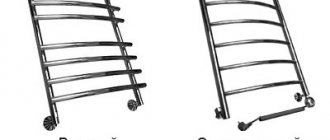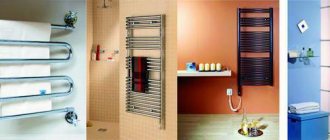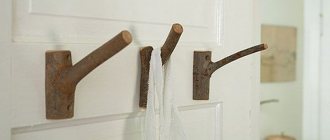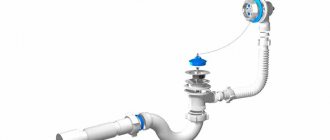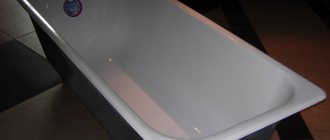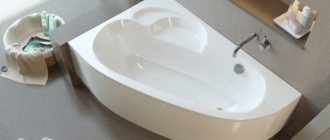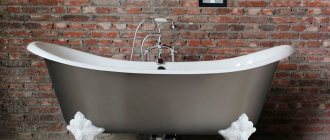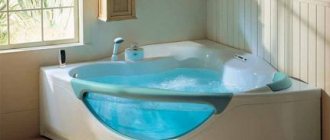A heated towel rail is not only a device for drying wet towels, but also a device for reducing humidity in the bathroom, which heats the room no worse than warm floors. The heated towel rail is not affected by the central heating system and operates 24 hours a day all year round. To decide which type of heated towel rails is better, let’s consider their advantages, and also consider its varieties:
- water;
- electric.
A water heated towel rail must first of all be reliable
Characteristics
If you always want to have warm and dry laundry, then you need to install a heated towel rail in the bathroom. Its fashionable design not only complements your bathroom well, but also adds a decorative touch. The heated towel rail will create a normal and comfortable temperature in the room, which will allow you to get rid of liquid condensation on the walls and mirrors, as well as high humidity in the bathroom.
Unfortunately, buying a low-quality device leads to unwanted flooding of your apartment, not to mention the neighbors below. Sometimes this happens due to bad specialists who install the heated towel rail poorly. To prevent this from happening, we will analyze the features of heated towel rails so that you buy and install it correctly in the bathroom.
There are three types of heated towel rails:
- electrical;
- water;
- combining water and electric options - combined.
The shelf life of a heated towel rail is about 30 years
Water appliances use water and the operation of a heated towel rail depends on the type of connection to the system, the coolant and throughput speed, the power of the device and the materials of manufacture.
Externally, the water device looks like an elegant battery, with pipes (of the same or different diameters) welded into a multi-channel heat exchanger. Having correctly installed a water heated towel rail, you will not have to control it, because the technical characteristics of the device correspond to heating radiators and it turns into a full-fledged bathroom heater.
Water heated towel rails are divided according to their appearance:
- to modernized ones with improved shelves;
- to standard ones, which look like a curved M or P tube;
- to stylish, that is, having a more original shape.
Water fixtures are manufactured from the following materials:
- Stainless steel. Their tops can be painted, polished or chrome plated.
- Non-ferrous metals that have a short service life because they are affected by hot water in heating circuits and the presence of impurities in the water that destroy pipes.
This heated towel rail is corrosion resistant
Installation
The connection procedure consists of the following steps:
- First you need to dismantle the old coil.
- It is necessary to make a bypass. For this, ball valves are used, and corner fittings are also needed.
- A new coil must be installed in the old place.
Installation of a heated towel rail begins with determining the place most convenient for its placement. You can connect the coil yourself; for this you will need a standard set of tools.
- The unit must be equipped with exhaust valves, they are called Mayevsky taps. If the need arises, the valve can easily remove the air collected in the pipe. This increases the thermal conductivity of the product.
- At the final stage, the system must be checked for leaks.
After this, you can use an electric or water coil.
Water heated towel rail: pros and cons
If you want to save money on installing and using a heated towel rail, then a water heated towel rail is suitable for you. It does not require the use of electricity to function properly. And it’s easy to connect a water heated towel rail to the hot water supply system.
Before you buy a water heated towel rail, you will have to measure the diameter of the landing pipes with a caliper (ruler), since modern pipeline diameters are 32 mm or 40 mm (an inch and an inch and a quarter). Overseas hydronic heated towel rails are designed for 16mm (half an inch) or 25mm (¾ inch), which results in mismatched pipes, hence you will not be able to install a hydronic unit. To do this, you will have to purchase adapters.
Be careful that the technician, when installing a water heated towel rail, connects it to the required system - hot water supply, not heating. Otherwise, you'll be left with a cold heated towel rail while the central heating sits idle.
Water heated towel rail
The disadvantages of water heated towel rails are that the device installed to the hot water supply system will give you, along with hot water, high operating pressure in the system, pressure testing, internal scale and water hammer. And all this can result in a leaking heated towel rail and flooding the neighbors below with hot water. Therefore, a water heated towel rail must be:
- resistant to oxidation;
- reliable;
- corrosion;
- resistant to scale inside pipes.
Models of water appliances using metal, seamless, seamless, thick-walled pipes with a thickness of 2.5 to 3.0 mm are very popular among the population. Devices made of corrosion-resistant brass and stainless steel are considered reliable. There are options for water heated towel rails, where the inside of the pipes are protected with polymer coatings.
Choice
In specialized stores, sellers recommend a water heated towel rail made of aluminum or in the form of beautiful tubes, with a wall thickness of 1.0-2.0 mm, assuring that it will serve you for many years. They will be only half right, since such a water heated towel rail cannot be used in urban environments - it is not able to withstand the peculiarities of hot water supply. They are more intended for a home or cottage.
Ladder type heated towel rail for the bathroom
When purchasing a water appliance, make sure that it is equipped with an air release valve. It will come in handy in a situation where, when the heated towel rail is filled with water, you need to bleed the air out of it. If this is not done, you will end up with an air lock that will block the circulation of water through the system and render the device useless.
What additional things to pay attention to when buying a water heated towel rail:
- Check the pressure in the water supply system so that the heated towel rail does not fall below this value.
- Make sure you have a passport for the water device and a warranty card.
- What material is the water heated towel rail made of? Stainless steel is considered the most reliable.
- When buying a water device for a country house, any model with any pressure test will suit you, but for an apartment this issue needs to be clarified in advance.
- The pipe must be without seams, otherwise the seam may separate under the influence of high water pressure in a multi-story building.
- Pipes must be coated with chrome or enamel. It can be polymerized or painted.
Products made of “black” steel
Black steel heated towel rails
are distinguished by the fact that their internal surface does not have an anti-corrosion coating. As a result, they do not tolerate aggressive environments well. As a result, it is better to install them in private homes in autonomous systems where there are no large pressure drops.
The most important advantage of these models is their very low price compared to products made from other materials.
Pros and cons of an electric heated towel rail
An electric heated towel rail has the following advantages:
- easy to install;
- it will always be hot, even when the hot water is turned off;
- convenient thermostat;
- affordable price;
- installs anywhere in the bathroom;
- helps save on electricity.
Option with swivel stands
In this case, electrical appliances are divided into:
- rotary;
- stationary;
- filled with oil;
- heating cable;
- combined, combines oil and cable options;
- floor-mounted, installed under ceramic tiles in the bathroom;
- wall-mounted, mounted on the wall with brackets.
Regarding color and shape, specialized stores will offer you a wide selection of heated towel rails that are suitable for any bathroom design. Heated towel rails in chrome, white or gold shades remain very popular.
Having decided to install an electric heated towel rail, you will have to choose an option for connecting it:
- open, a regular plug and socket are used, but it is better to install the socket in the corridor for safety reasons;
- hidden, when all the wires are hidden in the wall, which does not allow water to get to the electrical network, therefore, there will be no short circuit.
Electric heated towel rail never leaks
Peculiarities
Electric heated towel rails are similar in shape and size to water ones. Their main advantage is that you do not have to connect them to the hot water supply system. You just need to hang them on the brackets and you can start using them. If this is quite enough for stationary models, then they make models that are placed on the floor (floor-standing) and you can rearrange them both around the perimeter of the bathroom and transfer them to other rooms. For them to start working, just connect the heated towel rail to the mains. Electric heated towel rails heat up to 50-70 degrees.
The heat sources in electrical appliances are built-in heating elements or electric heating cables. The coolant is mineral or vegetable oils and their mixtures, water or antifreeze, which have high thermal conductivity. They can also leak, but this will not threaten you on the same scale as with a water heated towel rail. The electrical outlet must be moisture-resistant, otherwise water may penetrate into it and cause a short circuit or even a fire.
The downside of an electric heated towel rail is its energy consumption. Even though electric heated towel rails have energy-saving properties, you can try to reduce the cost of using them. For example, you don’t necessarily have to keep them on all the time, but use them only when you need them. All modern electric heated towel rails are equipped with a thermostatic head, which allows you to adjust the temperature of the device according to your wishes. That is, just turning the handle is enough to quickly dry a towel or heat a bathrobe.
An electric heated towel rail will save you from headaches about leaks.
You can purchase a thermostat that will allow you to control the temperature you need without spending extra money. The thermostat controls the turning on and off of an electrical appliance depending on the room temperature. And if you equip it with a timer, you will get an automated system, to start which you just need to set the program.
As you can see, managing the heating of an electric heated towel rail is not only simple, but also profitable. For example, you can set the device to turn on in the morning to enjoy a cozy room, not to mention a warm robe and towel.
In conclusion, I would like to mention combined heated towel rails, which have the advantages of an electric and water device and their disadvantages. The universal thing about them is that if you don’t have electricity, hot water will provide you with heat and vice versa.
Floor dryers
Floor heated towel rail
There are all three types (water, electric, combined). The choice of one type or another depends on the location of its installation. If the heated towel rail is installed far from the water supply, the choice falls on the electric type (for example, a hallway). If installation takes place in the bathroom or rooms, near water supply pipes, then it is worth installing combined or water models. It is possible to install a dryer instead of a radiator. In this case, it is installed against the wall. There is a design solution when a heated towel rail separates a combined bathroom, separating the bathtub from the toilet.
It is worth noting the convenience of a mobile floor dryer. If necessary, the device can be moved to a particular room.
In addition to stationary “immovable” models, there are water-based rotary products.
Swivel heated towel rail
They are equipped with a rotating mechanism that rotates its individual parts 180 degrees. Unlike stationary models, a rotary dryer is considered less reliable due to wear of the sealing rings in the design. The typical service life of rotary products is no more than 3 years. Also, instead of a rotating product, you can use a regular stationary one with an additional removable and rotating mechanism equipped with several slats. An electric rotary heated towel rail is more practical and reliable than a water one, thanks to the elastic heating cable.
Manufacturers and prices
Of course, it’s better to trust trusted manufacturers, but you don’t have to overpay. Here is a small list of companies that produce reliable and high-quality models of devices:
- Sunerzha (St. Petersburg). The simplest water heated towel rail is U-shaped, has a power of 0.5 kW and costs from 1800 rubles. A water heated towel rail from the “Elegy” series will cost between 7500-13500 rubles.
- (Russia) produces 53 models of M-shaped and U-shaped heated towel rails. The basic model costs 1,600 rubles and goes up to 10,000 rubles.
- . It produces water heated towel rails of economy class "Margroid" from 800 rubles and reaching 1650 rubles and above (Margroid series). Premium class heated towel rails will cost you from 3,500 rubles to 7,340 rubles.
Heated towel rail
Of course, there are heated towel rails not only from the above companies. But these companies will help you navigate when choosing a particular model and find out how much you will have to pay.
Now you know what to look for when buying heated towel rails and what features water or electric appliances have. It is important that they are of high quality and reliable, suitable for the conditions of your thermal systems.
Conclusion
A hydronic heated towel rail is good for heating a bathroom, but installation problems may arise. Electric models do an excellent job of drying towels, but only powerful options can warm up the room. Thermostats are a must for them, otherwise the electricity bills will become unaffordable. Combined models are capable of any task, the main disadvantage is the high price. The Praktika online store sells heated towel rails from imported and domestic manufacturers. Delivery is available in St. Petersburg and Leningrad Region. If you have any questions, request a call back. The manager will call you back within a few minutes and help you choose the best model for your bathroom.
List of worthy ones
Now it’s worth getting acquainted with those companies that are comfortable exposing their products to a wide audience. Moreover, they not only work to improve it, but also carry out strict quality control, preventing defects. The list of such worthy manufacturers includes:
- Arbonia (Germany).
- Margaroli (Italy).
- Zehnder (Germany).
- Warmos (Finland).
- Vogel&Noot (Australia).
Among domestic manufacturers we can highlight “Tera”, “Trugor”, “Dvin”, “Terminus”. They also managed to prove themselves from the best side. At the same time, most companies have a direct connection with consumers and listen to their opinions when creating new models.
Large companies also have a staff of professional designers. Together with designers, they make every effort to create original designs that will fit perfectly into the interior of the bathroom.
